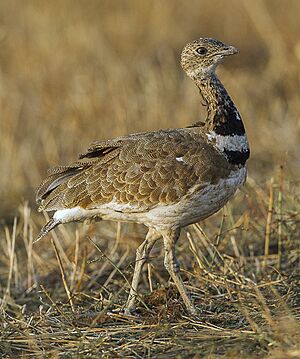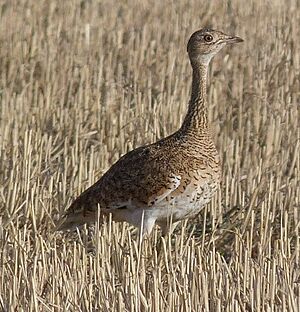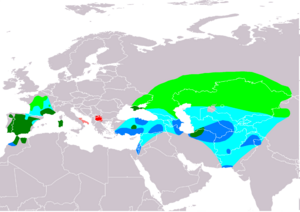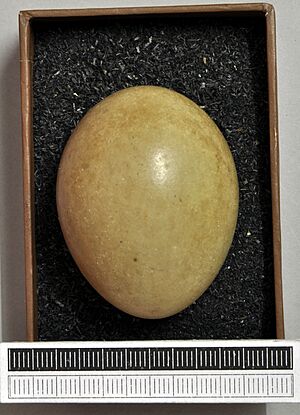Little bustard facts for kids
Quick facts for kids Little bustard |
|
|---|---|
 |
|
| Male | |
 |
|
| Female | |
| Conservation status | |
| Scientific classification | |
| Genus: |
Tetrax
|
| Species: |
tetrax
|
 |
|
| Range of T. tetrax Breeding Resident Non-breeding Passage Probably extinct Extinct | |
| Synonyms | |
|
Otis tetrax Linnaeus, 1758 |
|
The little bustard (Tetrax tetrax) is a type of bird that belongs to the bustard family. It is the only bird in its group, called Tetrax. The name Tetrax comes from an old Greek word for a gamebird.
Contents
Where Little Bustards Live
Little bustards live and have their young in Southern Europe, Western Asia, and Central Asia. Some birds in southern Europe stay in the same place all year. However, many others fly south for the winter to warmer areas.
Sadly, the number of little bustards is going down. This is because they are losing their natural homes. For example, they used to live in the grasslands of Hungary, but they are no longer found there. They are also very rare visitors to places like Great Britain.
In 2013, a very rare little bustard was found in Cyprus. It had been shot by people hunting illegally. This was a big deal for people who care about birds. The little bustard had not been seen in Cyprus for a very long time.
What Little Bustards Look Like
The little bustard is the smallest bustard in its region, but it's still about the size of a pheasant. It grows to be about 42 to 45 centimeters (17 to 18 inches) long. Its wings can spread out to 90 to 110 centimeters (35 to 43 inches) wide. It weighs about 830 grams (29 ounces).
When it flies, you can see a lot of white on its long wings. The male little bustard, during breeding season, has a brown back and a white belly. Its head is grey, and its neck is black with white stripes above and below.
Female little bustards and males not in breeding season look different. They don't have the fancy black and white neck pattern. Females also have darker markings on their bellies than males. Young bustards look a lot like the females.
Most of the time, both male and female little bustards are quiet. But the male has a special sound. It makes a "raspberry-blowing" call that sounds like prrt.
What Little Bustards Eat
Little bustards eat many different things. They are omnivorous, which means they eat both plants and animals. Their diet includes seeds, insects, small rodents, and even reptiles.
Reproduction and Life Cycle
Like other bustards, the male little bustard performs a special dance to attract a female. He stamps his feet and leaps into the air. After mating, the female lays 3 to 5 eggs directly on the ground.
Where Little Bustards Live and How They Behave
Little bustards prefer open grasslands and farms where the plants are tall enough to hide them. Both male and female birds like the same kinds of places to live.
They usually walk slowly and gracefully. If something scares them, they tend to run away instead of flying. Little bustards like to be with other birds, especially in the winter.
Scientists have tracked male little bustards and found that they fly at night. They often stop in farm fields, both watered and dry, to rest. This helps them reach better feeding areas after the breeding season.



